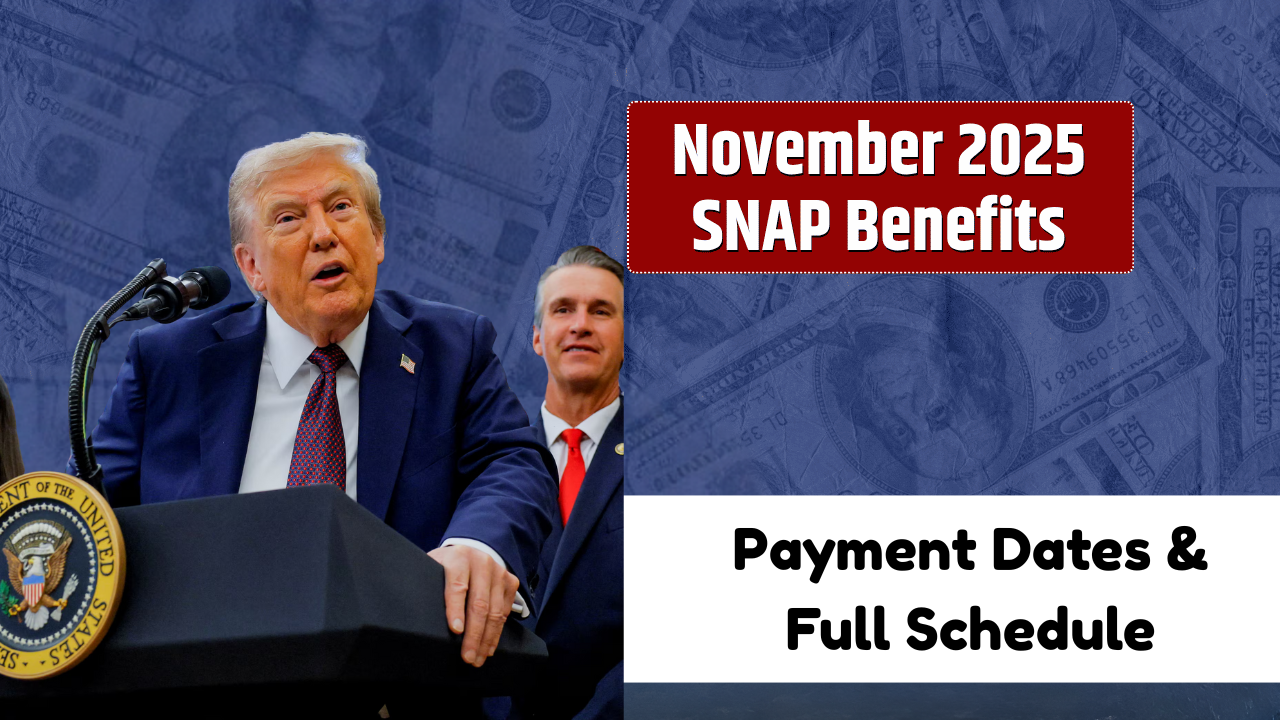For millions of Americans, the start of November brings a familiar question: When will my SNAP benefits arrive?

The Supplemental Nutrition Assistance Program (SNAP) — the nation’s largest food assistance program — continues its regular electronic benefit transfers (EBT) this month, serving more than 42 million people nationwide. But November 2025 also ushers in something new: a federal eligibility overhaul that could reshape who qualifies for benefits in the months ahead.
Officials stress that payments will arrive on time and as scheduled, but behind the scenes, state agencies are preparing for one of the most significant eligibility shifts in more than a decade.

When November SNAP Benefits Arrive?
There is no single federal payment day for SNAP. Each state issues benefits on its own schedule, usually between the 1st and the 20th of each month. Deposit timing depends on factors such as your case number, county, or even the first letter of your last name.
Recipients can confirm dates through their state EBT portal or the USDA’s official SNAP State Directory.

Sample November 2025 Distribution Schedule
| State | Deposit Window | Basis for Schedule |
|---|---|---|
| California | 1st – 10th | Last digit of case number |
| Texas | 1st – 15th | Last two digits of EDG number |
| Florida | 1st – 28th | 8th and 9th digits of case number |
| New York | 1st – 9th | Varies by county |
| Illinois | 1st – 20th | Case number or Social Security Number |
| Georgia | 5th – 23rd | Last two digits of ID number |
Actual dates can shift slightly due to holidays or system maintenance, so recipients should check their state’s online EBT calendar before budgeting for the month.
How SNAP Works?
SNAP provides a monthly food benefit loaded onto an Electronic Benefit Transfer (EBT) card — the digital successor to paper food stamps. Funds can be used at most grocery stores, farmers markets, and major online retailers such as Walmart and Amazon.

On average, benefits equal about $202 per person per month, though amounts vary based on household size, income, and housing costs.
The Big Change: The OBBBA and Work Requirements
Starting this month, a new set of federal rules takes effect under the One Big Beautiful Bill Act (OBBBA), which modifies how states determine SNAP eligibility — particularly for a group known as ABAWDs: Able-Bodied Adults Without Dependents.

Who Counts as an ABAWD?
- Adults aged 18 – 64
- No dependents
- Physically and mentally capable of working
Under previous law, ABAWDs could receive benefits for only three months in a three-year period unless they worked, trained, or volunteered at least 80 hours per month.
The OBBBA tightens these rules, expanding verification requirements and narrowing automatic exemptions. Some older adults, veterans, and previously exempt unhoused individuals must now document their work or volunteer hours monthly to continue receiving benefits.
“This is a major administrative lift for states,” said Allison McCrae, a policy analyst at the Center on Budget and Policy Priorities. “They’ll have to verify more recipients every month with the same limited staff.”
Who Still Qualifies for an Exemption?
The tougher framework does not apply to everyone. The U.S. Department of Agriculture (USDA) lists several exemption categories:
- Individuals with physical or mental disabilities
- Pregnant individuals
- Caretakers of children or incapacitated adults
- Persons medically certified as unfit for work
These groups remain eligible but must submit documentation proving their status. Failure to update paperwork on time can lead to temporary benefit suspensions until verification is complete.
Common Exemption Errors to Avoid
- Assuming a past exemption automatically renews
- Forgetting to report a medical or caregiving status change
- Missing mail or text reminders from the state SNAP office
“Even an honest paperwork delay can stop your benefits for a month or more,” warned Tasha Rogers, director of the Dallas County Food Security Coalition. “Keep your contact info current and open every letter from your SNAP agency.”
Political and Moral Debate Over the Changes
The new rules are reigniting long-running political debates about the purpose of SNAP — and the balance between support and self-sufficiency.
Supporters of the stricter guidelines, primarily fiscal conservatives, frame them as a step toward accountability. They argue that able-bodied adults should engage in work or training to maintain eligibility and reduce dependency on federal aid.
Critics, however, see the change as punitive.
“SNAP is meant to fight hunger, not test work ethics,” said Kelly Rowe, policy director for a New York anti-hunger coalition. “We’re talking about people already on the edge. Cutting them off after 90 days doesn’t create jobs — it just deepens poverty.”
Even within the USDA, officials acknowledge that implementation will strain already thin resources. Many state agencies are still recovering from pandemic-era backlogs and staff shortages.
What SNAP Recipients Should Do Now?
To protect benefits during the transition, experts recommend taking a few proactive steps:
| Step | Action |
|---|---|
| 1. Read every notice | Watch for letters, emails, or texts from your state SNAP office about new requirements or verification deadlines. |
| 2. Track your hours | If you work, volunteer, or train, document your hours each month in writing or online. |
| 3. Update your contact info | Log into your EBT or state benefits portal to confirm your address, email, and phone number. |
| 4. Ask about exemptions | Contact your local SNAP office to determine if you qualify for a disability, caregiving, or age-based exemption. |
| 5. File an appeal if cut off | Every state offers a fair hearing process if your benefits are denied or suspended. |
Most states require appeals to be filed within 90 days of the decision notice, and you can often keep receiving benefits during the appeal if you act quickly.
Food Banks Prepare for a Surge
Local aid organizations are bracing for more demand once the new work verification rules take effect.
“We’re preparing for longer lines and more emergency food requests,” said Marcos Ortiz, a volunteer coordinator at a Detroit community pantry. “When benefits lapse, even for a month, people come to us first.”
In Texas and Florida, where food insecurity rates already exceed 12 percent of households, food bank networks are expanding distribution hours and increasing holiday food drives in anticipation of benefit disruptions.
The Bigger Picture: Hunger, Inflation, and Self-Sufficiency
The debate over SNAP’s direction comes amid continued economic pressure for low-income Americans. The USDA’s Economic Research Service reported that 17 million households experienced food insecurity in 2024 — up sharply from pre-pandemic levels.
Food prices have risen roughly 20 percent since 2020, and wages have not kept pace. For many, even short interruptions in benefits can mean empty cupboards and skipped meals.
Economists note that while the new rules aim to promote independence, they may also lead to higher short-term hardship. Research shows that when benefits lapse, households often turn to charitable food programs, incur higher debt, or experience worse nutrition outcomes.
“Work requirements sound reasonable, but they assume stable jobs exist for everyone who wants one,” said Dr. Lydia James, a social policy researcher at Georgetown University. “When transportation, childcare, or health issues get in the way, people can lose access to food through no fault of their own.”
Looking Ahead: What to Expect
The USDA has instructed states to phase in the new OBBBA standards over the coming months, with full implementation expected by spring 2026. Until then, states must:
- Notify all affected recipients
- Update application forms and online systems
- Verify monthly work hours or exemption claims
- Manage an expected increase in appeals
The process will likely be uneven across states, meaning some recipients may see enforcement sooner than others.
FAQs: November 2025 SNAP Payments
When will I get my SNAP benefits this month?
Most states deposit between November 1 – 20, depending on your case number or name. Check your state’s EBT portal for exact dates.
Will my benefits stop because of the new law?
Not automatically. But if you’re an ABAWD and don’t meet the 80-hour monthly work requirement (or fail to verify it), benefits may be limited to three months.
I’m disabled. Do I still have to meet the work rule?
No. People with disabilities are exempt but must provide documentation to maintain that exemption.
Are veterans or unhoused individuals still exempt?
Some are, but the OBBBA ends automatic exemptions for several groups. Eligibility will now be determined case by case.
How can I check my payment date or eligibility status?
Visit your state’s EBT portal or the USDA SNAP State Directory for contact information, payment calendars, and updates.
Stay Informed, Stay Connected
SNAP remains one of America’s most essential safety nets, but November 2025 marks a turning point. Payments continue to flow normally, yet the new eligibility rules could reshape the program’s reach in the coming year.
For recipients, the message is clear: read every notice, document your hours, and stay in contact with your local office.
As the policy debate continues, the reality on the ground remains the same — millions rely on SNAP not just for food, but for stability. Ensuring those benefits remain accessible, fair, and effective will test both state agencies and the nation’s commitment to fighting hunger.

